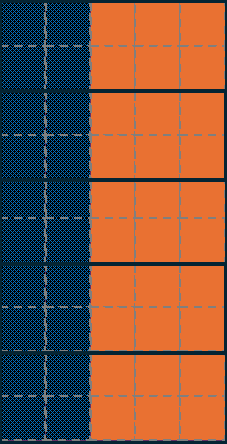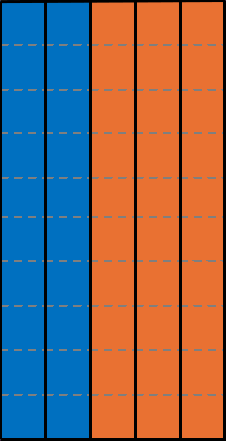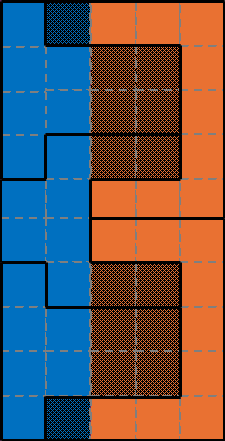Plurality Voting (FPTP)
Pick One (1), One (1) Winner
Plurality Voting, also known as First Past the Post Voting, is a method where the option selected with the most votes win.
Test Your Knowledge
This Webpage and Video Have a Quiz you can take to test your knowledge and understanding of the content. This lesson is part of a larger education series.
| Candidate Selection |
|---|
| Candidate | Faction | Count | Vote Share |
|---|---|---|---|
| A | 🟥 Red | 50,000 | 5% |
| B | 🟧 Orange | 250,000 | 25% |
| D | 🟨 Yellow | 200,000 | 20% |
| F | 🟩 Green | 120,000 | 12% |
| G | 🟦 Blue | 300,000 | 30% |
| J | 🟪 Purple | 80,000 | 8% |
Plurality Vote Share
A Majority (over 50%) is NOT required to win in this system.
Plurality Outcome
Regardless of the number of options, the choice with the most votes prevails over all others even if the choice itself has non-majority support.
Plurality Seat Control
In this example G🟦(Blue) triumphs over 70% of voters with 30% support.
Plurality Committee Control
Problems At Scale over Time
Voters compromise their own interests and coalesce permanently under a single identity and banner after each election until two permanent camps emerge and swap power between themselves over time.
1st Election Cycle
Blue🟦 wins with 30% of the vote, capitalizing on the divided opposition. In response, 🟨 Yellow decides to merge with Orange🟧 for the next election, aiming to strengthen their combined position.
| Faction | Count | Vote Share |
|---|---|---|
| 🟥 Red | 50,000 | 5% |
| 🟧 Orange | 250,000 | 25% |
| 🟨 Yellow | 200,000 | 20% |
| 🟩 Green | 120,000 | 12% |
| 🟦 Blue | 300,000 | 30% |
| 🟪 Purple | 80,000 | 8% |
2nd Election Cycle
In the second election, Orange🟧 wins with 45% of the vote, thanks to the support from 🟨 Yellow. In response, Blue🟦 and Purple🟪 consolidate with Green🟩for the next cycle, aiming to build a stronger coalition.
| Faction | Count | Vote Share |
|---|---|---|
| 🟥 Red | 50,000 | 5% |
| 🟧 Orange | 450,000 | 45% |
| 🟩 Green | 120,000 | 12% |
| 🟦 Blue | 300,000 | 30% |
| 🟪 Purple | 80,000 | 8% |
3rd Election Cycle
Orange🟧 loses with 45%, as Blue🟦 wins with 50%, leveraging the vote split caused by Red🟥. Following this, Red🟥 consolidates under Orange🟧, resulting in a two-party system in subsequent cycles.
| Faction | Count | Vote Share |
|---|---|---|
| 🟥 Red | 50,000 | 5% |
| 🟧 Orange | 450,000 | 45% |
| 🟦 Blue | 500,000 | 50% |
Two Party Deadlock
In subsequent Election Cycles, two parties consolidate power and are incentivized to keep it for themselves. Power balances on a razor's edge in an escalating arms race of opposing ideologies.
| Faction | Count | Vote Share |
|---|---|---|
| 🟧 Orange | 510,000 | 49% |
| 🟦 Blue | 490,000 | 51% |
| Faction | Count | Vote Share |
|---|---|---|
| 🟧 Orange | 490,000 | 49% |
| 🟦 Blue | 510,000 | 51% |
The Spoiler Effect
Plurality voting makes it impossible for alternate voices to be heard by making less established factions unelectable.
| Faction | Count | Vote Share |
|---|---|---|
| 🟧 Orange | 500,000 | 50% |
| 🟦 Blue | 450,000 | 45% |
| 🟪 Purple | 50,000 | 5% |
Every time a small party gains traction, the vote breaks in favor of the ideological opposite of the smaller party.
| Faction | Count | Vote Share |
|---|---|---|
| 🟧 Orange | 470,000 | 47% |
| 🟨 Yellow | 30,000 | 3% |
| 🟩 Green | 20,000 | 2% |
| 🟦 Blue | 480,000 | 48% |
Under Plurality Voting, voting for one’s actual interests is disincentivized.
| Faction | Count | Vote Share |
|---|---|---|
| 🟥 Red | 50,000 | 5% |
| 🟧 Orange | 450,000 | 45% |
| 🟦 Blue | 500,000 | 50% |
Autocratic Emergence
Over time democratic rule decays into autocratic rule and it’s accompanying consequences.
Strategic District Drawing
Power structures draw electoral maps so that future election results are likely to favor the status quo. This leads to autocratic election outcomes in most areas, resulting in government structures being unaccountable to the governed.
| Faction | Count | Vote Share |
|---|---|---|
| 🟧 Orange | 600,000 | 60% |
| 🟦 Blue | 400,000 | 40% |
Strategic Configuration 1
In this configuration, the districts are drawn in such a way that Orange🟧, despite having 60% of the vote, wins all 5 districts, effectively locking out Blue🟦 from representation entirely.
| 🟧 Orange | 🟦 Blue |
|---|---|
| 5 | 0 |

Strategic Configuration 2
This configuration creates a slightly more balanced distribution, where Orange🟧 wins 3 districts and Blue🟦 wins 2. Here, the district lines are drawn to ensure that Orange🟧 retains a majority but allows some representation for Blue🟦.
| 🟧 Orange | 🟦 Blue |
|---|---|
| 3 | 2 |

Strategic Configuration 3
In this configuration, the districts are manipulated to favor Blue🟦 with 3 districts, while Orange🟧 wins only 2, despite Orange🟧 having a majority of the overall vote (60%). This is achieved by spreading Orange🟧 voters thinly across more districts while concentrating Blue🟦 voters in just enough districts to secure a win.
| 🟧 Orange | 🟦 Blue |
|---|---|
| 2 | 3 |

Defund Election Infrastructure
For the districts that are not predictable, or are predictably against the status quo, voting infrastructure can be removed, and barriers to voting and standing for office are put in place.
Target Rival Interests for Disenfranchisement
Target behaviors or attributes commonly associated with members of rival political blocks. Make it illegal and use it as a pretense to remove the right to vote.
Poll Taxes and Hidden Fees
Exploit Financial hardships in the most likely to be upset with the status quo to keep as many from voting as possible.
Non-Automatic Registration
Disenfranchisement via technical paperwork that need not exist in the first place.
Unsubsidized Identification Requirements
When combined with Registration Fees and Travel requirements, acquiring identification documents is a financial and time burden that applies disproportionately against those not benefiting in the status quo.
A More Representative Way: Proportional Ranked Choice Voting (PR-RCV)
No other system comes close to having the final outcome match the voters interests.
Plurality Voting (FPTP)
Proportional Ranked Choice Voting (PR-RCV)
Rank up to All, Multi-Winner [>=5]
PR-RCV is similar to RCV except there are multiple winners. This can be accomplished by increasing the number of winners per district OR by combining several districts into one larger district.
| Candidate | Faction | Count | Share |
|---|---|---|---|
| B | 🟧 Orange | 170,000 | (20%) |
| A | - 🟥 Red | 30,000 | 3% |
| D | 🟨 Yellow | 110,000 | (20%) |
| E | - 🟨 Yellow | 90,000 | 9% |
| F | 🟩 Green | 120,000 | (20%) |
| C | - 🟧 Orange | 70,000 | 7% |
| A | - 🟥 Red | 10,000 | 1% |
| G | 🟦 Blue | 200,000 | (20%) |
| J | 🟪 Purple | 80,000 | (15%) |
| I | - 🟦 Blue | 20,000 | 2% |
| G | - 🟦 Blue | 40,000 | 4% |
| H | - 🟦 Blue | 10,000 | 1% |
| · | Dropped | 50,000 | 5% |
Protects Diversity
Supports all political groups all the time.
Breaks Deadlocks
Resolves stalemates in two-party systems using unrepresentative voting methods like First Past the Post.
Enhances Efficiency
Improves the functioning of one-party/No-Party states by removing unproductive incentives in autocratic systems.
Empowers Party Members
PR-RCV Supports all political groups all the time.
Increases Leverage for Legislators
Provides individual legislators more power to represent their jurisdictions in negotiations with faction leadership.
Ensures Neutrality
Enables speakers, chairs, civil officers, and non-political appointees to remain truly neutral by balancing political pressures.
Promotes Cooperation
Encourages cooperative behavior and reduces combative behavior by creating a balanced political environment by making single faction majorities unlikely.
